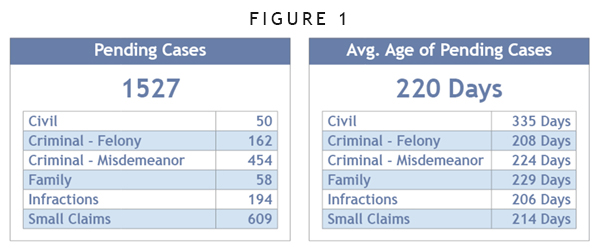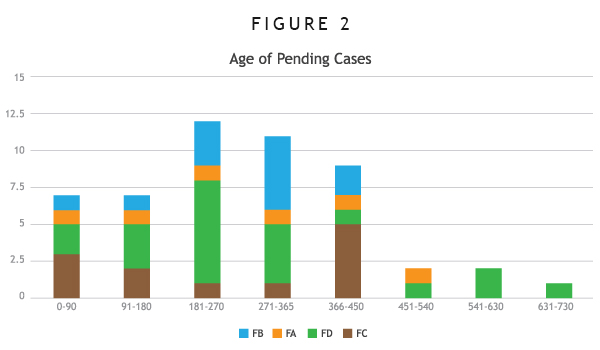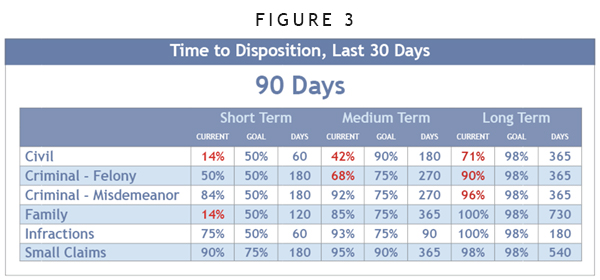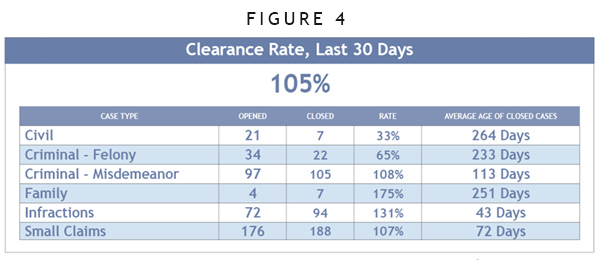In 2013, Grant County Courts, Law Enforcement, and Correctional Services approached the Division of State Court Administration’s (Division) Court Technology office with a grant proposal to fund a system-wide “dashboard” to monitor outcomes and improve efficiency across the entire criminal justice system in Grant County. Their idea was to centralize information from the computer systems in use at the jail, courts, and probation departments. They could then analyze the data to determine the efficacy of the county’s evidence-based programs. Grant County is one of seven participants in the National Institute of Corrections sponsored “Evidence Based Decision Making in Local Corrections Initiative” (EBDM).
Court Technology is creating a dashboard application in INcite. INcite is software developed by Court Technology that provides a suite of discreet applications for federal, state, and local court, clerk, and public safety agencies. Court Technology staff realized that, because Grant County uses the Odyssey Case Management System to manage their court cases, the dashboard items dealing with the court system in Grant County could be adapted to work with any court in the state that is also using Odyssey.
Based on this fact Court Technology spun the Court Measures portion of the Grant County dashboard into a separate INcite application called Odyssey Court Measures, with the goal of making it available to all courts using Odyssey.
At a plenary session titled “Innovating for Hoosiers: Embracing the Future with Court Technology” during the September Judicial Conference, Henry Circuit Court Judge Mary Willis presented the Odyssey Court Measures application that uses measurements developed by the National Center for State Courts (NCSC). The NCSC calls these measures “CourTools.” A detailed explanation of these tools is available at courtools.org. Three of the ten CourTools are data-driven, and the Odyssey Court Measures application in INcite uses data from the Odyssey Case Management System to present these three measures.
The Odyssey Court Measures application requires no additional data entry or input from users. Data is collected from Odyssey based on entries the court staff has entered for the Quarterly Court Statistical Reports (QCSR). There is no extra training or work involved for the judge or court staff.

The Average Age of Pending Cases is the first tool. (See Figure 1). This tool measures the number of days from case initiation through the present date. The home screen of Odyssey Court Measures displays the number of cases pending in the following categories: Civil, Criminal Felony, Criminal Misdemeanor, Family, Infractions, Juvenile, Probate, and Small Claims. The application also displays the average number of pending days for cases in each category.
Cases are not counted in which a party has an active warrant or writ, and the days between the issuance and service of a warrant or writ are not counted when determining the age of the case. The ability to view and track pending cases is important since these cases require further action by the court. Judges can use this information to ensure that all cases are being disposed in appropriate timeframes. (See Figure 1).
The Odyssey Court Measures application also allows users to “drill down” into the data and see exactly which cases are pending, and for how long. The application allows users one-click access to the Chronological Case Summary in Odyssey, giving them the ability to review the events in that particular case.

Clicking on the “Avg. Age of Pending Cases” link takes the user into the detail portion of the application, where they can graph, filter, and display data in a variety of ways. The following example shows the age of pending felonies. Users can group data and filter by case type, level, and time period. (See Figure 2).

The second tool in Odyssey Court Measures deals with Time to Disposition. (See Figure 3). This tool can be used to compile all cases that were disposed in a particular period of time. On the home page of the application, the time frame is set for 30 days; however, users can set a different time period as needed. The application uses the statistical closure entered on the case in Odyssey to determine when a case was disposed. Once the application has determined the pool of cases, it calculates the average time between filing and disposition for each case type category. The NCSC has established time standards for various case types as approved by the Conference of Chief Justices, the Conference of State Court Administrators, the American Bar Association, and the National Association for Court Management. These standards can be found on the NCSC website.
The application displays the Time to Disposition data in three columns: Short Term, Medium Term, and Long Term. Court may set its own goals for the percentage of cases and the time to disposition. The NCSC has recommended default goals that a court might adopt. The application will display the goals set by the court, along with the actual percentage of cases disposed of within the time period specified. Categories of cases where the goal is not being met are displayed in red. In the following example, this court set disposition goals for misdemeanor cases of 50% within 180 days, 75% within 270 days, and 98% within 365 days. The court is meeting its short and medium term goals, but fell short of its long term goal, disposing of 96% of misdemeanor cases within 365 days. (See Figure 3). The court could use the first tool, Average Age of Pending Cases, to find the civil cases that have been pending for the longest amount of time, and concentrate its effort on those cases.

As with other Odyssey Court Measures tools, users have the ability to “drill down” into the Time to Disposition data. The user is free to filter, graph, and display information in detail based on case type, level, and time period.
The third tool in Odyssey Court Measures is Clearance Rate (see Figure 4), defined as the number of disposed cases as a percentage of the number of incoming cases. This statistic is calculated simply by dividing the number of disposed cases by the number of filed cases during a particular time period. The Odyssey Court Measures application defaults to the clearance rate for the past 30 days, but the user can choose to display the past 60, 90, 180, or 365 days. If a court disposed of more cases than were filed in the selected time period, the clearance rate will be over 100%. The application also displays the average age of the cases disposed of in the time period.
This is an important tool that can be used to ensure that a court is not developing a growing backlog of cases. In the samples shown here, the average age of the small claims cases closed by the court is 72 days (see Figure 4). However, the average age of all of the court’s pending small claims cases is 214 days (see Figure 1). This should alert the court that it needs to concentrate on some of the older cases on its docket.
Odyssey Court Measures is currently being tested by six judges across the state. Judge Dana Kenworthy, Grant Superior Court 2, said: “I’ve used the application to review the two oldest case categories and identified multiple cases that could be closed. I did this in about 30 minutes, much faster than the old way. I love it!”
The tools in Odyssey Court Measures enable courts to review their caseloads, provide case-level detail, and assist in setting and meeting goals. The Division of State Court Administration is committed to assisting courts in becoming as efficient as possible. When combined with the Odyssey Case Management System, the new Odyssey Court Measures application in INcite gives judges and court staff a powerful tool to help them streamline their processes to better serve the public.